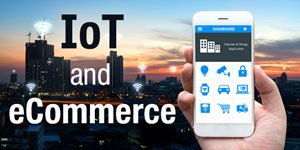eCommerce Is Benefiting From IoT More Than You Think
Internet of things (IoT) is a generic name for a broad range of systems. Any network of interconnected  devices could be called a part of the IoT. If your phone communicates with your car to turn the heating/AC on when you get near — that’s technically part of the IoT.
devices could be called a part of the IoT. If your phone communicates with your car to turn the heating/AC on when you get near — that’s technically part of the IoT.
If you have a digital assistant device in your home, that’s part of the IoT. The thing that makes IoT different is that the devices are communicating with each other directly. (The term “internet of things” isn’t even new — though it has only become a mainstream topic in recent years. As early as 1982 Coca-Cola was implementing vending machines that reported how much stock they had left, and whether the drinks were cold).
Industries across the globe are benefiting from IoT, and eCommerce is no exception. Below I’ve looked at some of the many different ways IoT is making eCommerce better for merchants and customers alike.
Recommended reading: Cross-border eCommerce and the current state of play
Inventory Management
Managing stock is a real hassle, and doing a complete inventory is probably the most tedious part of managing a stock-based business. It’s easy for peoples to make mistakes when doing repetitive counting tasks — leading to ambiguity you just don’t want.
Using RFID chips can drastically lower the human hours required to track your inventory, and increase the accuracy of the results. Use a system of passive chips that can be detected as they move past a sensor, or active chips that check in with your computer systems as often as you like.
These chips can also assist warehouse workers in finding the correct items, so you won’t have to spend as much time or money correcting mistakes down the line. Then there is probably the oldest IoT use case that’s still applicable today: detecting when you’re running low on a product and automatically ordering more before you run out. You still want humans overseeing parts of the inventory process, but you can use IoT to drastically reduce the workload associated with maintaining stock.
Smart Homes
Smart home systems are currently the most common consumer applications of IoT, and they signify a sea-change in the way consumers will buy things online in the future. Rather than sitting down at their computer and browsing for the item they want, they will simply tell their assistant to buy it.
This lowered effort required to make a purchase is good for all eCommerce brands, but it will lead to drastic changes in marketing. Not only will it mean a departure from the sales funnel we have become familiar with, but eCommerce brands will have to optimize their websites and products to appeal to AI rather than the consumer.
For example, if a user asks their virtual assistant to buy some kitchen paper, the assistant is likely to select the same product for everyone who makes that request. This could lead to a significant boost in sales for the item in the top spot, while others are ignored entirely. So in the same way we now optimize our websites for Google’s search algorithms, we might have to appeal to assistant AI’s...
Amazon Dash Buttons
Dash buttons are small, battery-operated branded devices for your home — and when you want more of the product, all you have to do is press the button. Dash buttons are an excellent way to establish your brand in a household long-term.
They also provide an opportunity for manufacturers of durable goods such as refrigerators to maintain a relationship with the customer over the decades-long lifespan of their product. In the future a refrigerator might come with several built-in customizable buttons that can be used to order your favorite products, or a verbal interface to order whatever you feel like.
Logistics
Tracking stock as it comes into your warehouse or goes to your customers can be made easier by integrating IoT. RFID and GPS technologies allow you to track every stage of an item’s journey, reporting how fast it’s traveling, who the driver is, or even the weather. Having this information at your fingertips allows you to automate much of the shipping process, and ensure there are no missing shipments or unforeseen delays.
Alternatively, you can focus on using IoT to enhance the delivery customer experience by sending automated messages informing customers of the status of their package. For example, you might send them a text a couple of days before the item will arrive, and then another a couple of hours before, so they won’t have to worry about missing the delivery.
You can include whatever sensors fit your needs. A supermarket delivering frozen goods might want to include temperature sensors to ensure the package is staying cool, and to alert the driver to take action if it’s getting too warm.
Consistent Marketing
There are countless consumer surveys that profess the importance of mobile phones to the purchasing process. But as long as mobile sites don’t deliver on usability, it’s clear that most people would rather go to their main computer to make any final decisions.
This creates a challenge for marketers. How do you intelligently tie your mobile and desktop marketing together for each individual customer? The Internet of Things is one way to detect devices that belong to the same individual, allowing you to market to the individual rather than the device, while still offering the correct ads for the platform. In fact, customer data is one of the core uses of IoT for eCommerce — improving everything from personalization to segmentation.
The current implementations of IoT eCommerce are just the humble beginnings of a technology that’s set to reshape all of commerce. It’s estimated that over 30 billion IoT devices will be in operation by 2020: with this kind of massive growth potential everyone who can start developing their own network, should.

Victoria Greene
Victoria Greene is a branding consultant and freelance writer. On her blog, VictoriaEcommerce, she shares tips on how new business owners can get their brand off the ground. She is passionate about using her experience to help fellow entrepreneurs succeed.